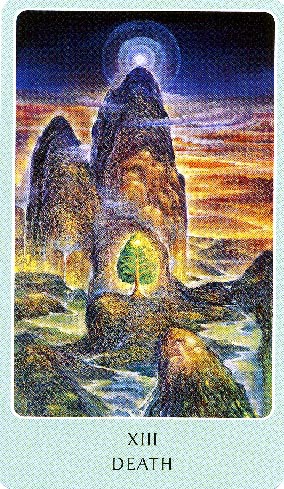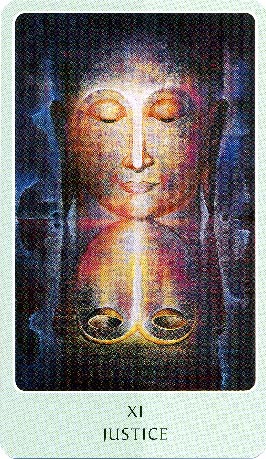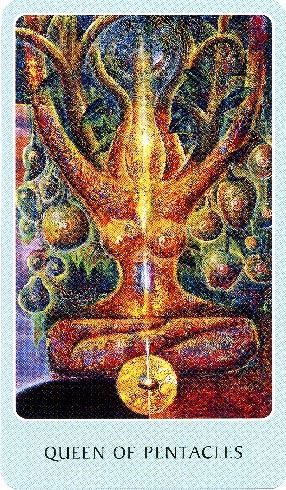
Roots of Asia Tarot is a fascinating fusion of Buddhist philosophy welded into the Western tarot paradigm. Both the deck and the excellent booklet that accompany the deck show the application of care, thought, and the united skills of artist Amnart Klanprachar and author Thaworn Boonyawan.
The faces of the gods and goddesses who populate the Major Arcana have been borrowed from the exotic pantheons of the Asian subcontinent. Klanprachar’s artistic renderings are an amalgamation of early Abstract and Cubist styles, the primitive South Pacific paintings of Gauguin, with a hint of Lady Frieda and Haindl. Textural painting techniques aid in deconstructing expected shapes, transforming them into palpable landscapes and human shapes. The forms are primitive yet generously organic and alive. The color palette is rich, dipping into hues and color combinations that are unusual to Western sensibilities.
Klanprachar departs from RWS-inspired images in the Major Arcana. He has a special gift for melding the human form into plant life and landscapes, and this is an important stylistic theme in the trump suit. In the Death card, a woman’s body doubles as a mountainous landscape. A river flows around her head, and a glowing tree rises from the solar plexus area. The woman is being reintegrated into the earth, and her body is a source of nourishment. Extremes of light and dark are another technique Klanprachar utilizes to manipulate form and function. In the Justice card, the placid face of Buddha is reflected in such a way to become a pair of scales beneath his face. The sheer simplicity of the idea and the execution amplify the dramatic impact of this card.
In the Court cards, the artist strives to portray specific personality types through background elements and body shapes. The Queen of Pentacles is a seated woman and also a tree in full fruit; the viewer is convinced of her wealth and generosity through the opulent combination of golds, ochre, and deep greens.
The images in the suits follow the RWS pips to an extent, but fresh placements, visual perspective, distance, and depth in the compositions make these images compelling. The elemental assignments are fire=wands, air=swords, water=cups, and earth=pentacles. Each suit has a mascot. The Pentacles are populated with elephants, the Wands with lions and tigers, the Cups with fish, and the Swords with birds and wings.
The 87-page booklet is well-organized and well-written. The Major Arcana cards are followed by the pips cards, and then the Court cards. The card descriptions are framed in terms of Buddhist philosophy, with great emphasis on the noble eight-fold path, ego detachment, and soul consciousness. Three intriguing spreads are offered: the Five Faculties of Power spread, a 7-card Chakhra spread, and a 23-card Wheel of Wisdom spread in which the cards are arranged in three concentric circles.
The booklet ends with a chapter on Insight Medication (Samatha-Vipassana), a technique taught in Theravada Buddhism. This meditation purports to give “guidance on how to see clearly into the nature of the mind.” Other exercises include sustaining attention, developing awareness of the body and of breathing, and cultivating good will towards self and others. These generous extras are a treat; when it comes to LWB’s, size matters.
This is a wonderful deck, not only for the unique beauty of the renderings, but also for the contemplative wisdom and unabashed morality of the card descriptions. It gets my vote as a primo acquisition for collectors as well.
~review by Elizabeth Hazel
Tarot deck by Amnart Klanprachar, book by Thaworn Boonyawan.
AG Müller, 2004 (www.tarotworld.com).
Produced in association with the Amaravati Buddhist Monastery, Hertfordshire, England.
Boxed 78-card deck and LWB. $25.00.
(previously published in the ATA Quarterly Journal, Winter 2007 issue)



